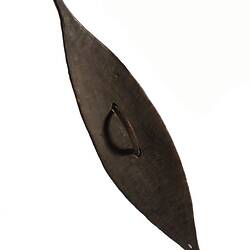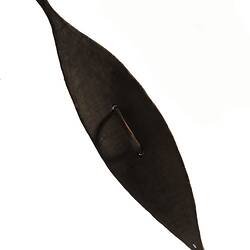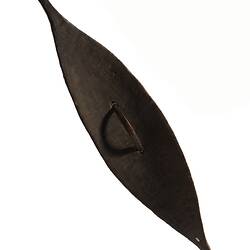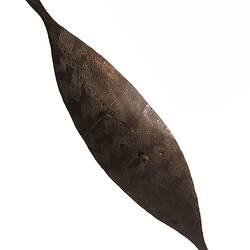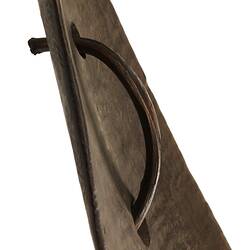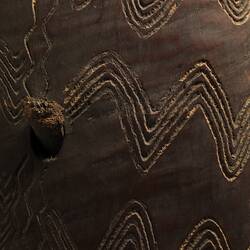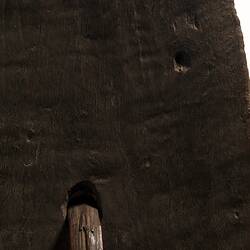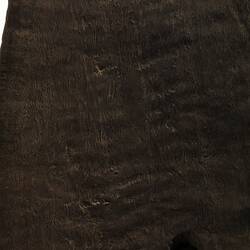Summary
This shield was made by a Ngarrindjeri man sometime around 1840. The Ngarrindjeri peoples are the traditional owners of the lower Murray River, western Fleurieu Peninsula and the Coorong area of southern, central Australia.
This shield features free-form flowing curves which are a common stylistic feature of designs from south-eastern Australia. Other common aspects of south-eastern designs can be seen in the use of geometric patterning and designs based on lines. Designs used by south-eastern Aboriginal groups have multilayered meanings and hold detailed information about the makers identity, clan grouping, Country, totems, stories and ceremony.
Shield designs are visually arresting, the elaborately incised and ochre designs create optical illusions during battle, a quality enhanced by the dexterity of the warriors. Ochres were used to make the incised designs stand out boldly.
Made from green bark cut from a eucalyptus tree, the shield is slightly convex in shape and has a small handle attached. The craftsman has shaped the piece of bark in the desired form and then placed it on hot ashes on a mound of earth, before covering it with heavy stones and earth. By the time the ashes were cold, the bark would have taken the curve of the mound. This shield has retained a slight twist in the bark. The handle is formed from a separate piece of green wood forced into the two holes cut into the shield; once dried, it is very difficult to remove.
This spear shield was one of the large amounts of material culture from south-eastern Australia that was taken overseas in the 19th and 20th centuries. It came into the Museum collection in 1995 following a donation by an international collector.
Physical Description
Pipette shaped shield with an attached handle. Both surfaces have been ochred. The posterior surface is without decoration. The anterior surface is decorated with a grooved continuous diamond pattern down the middle. To either side of this design the shield is covered with a grooved concentric zig zag pattern. Some of the grooved edges appear to have been stippled.
Significance
The Ngarrindjeri continue their strong connection to Country and their Ancestors by participating in cultural activities such as weaving and caring for Country that have been passed down over countless generations. The peak body of the Ngarrindjeri peoples is the Ngarrindjeri Regional Authority which has a host of directives aimed at serving the needs of the Ngarrindjeri peoples including cultural heritage, community and social services, political lobbying, policy and research and economic development.
The Ngarrindjeri people celebrate and share their culture at Camp Coorong which was established on Ngarrindjeri Country as a meeting place where non Aboriginal people can come to share in activities to learn more about Ngarrindjeri History, Arts, Crafts and the environment. The museum at Camp Coorong is a keeping place for many important Ngarrindjeri cultural items. Respected Ngarrindjeri Elder Uncle Tom Trevorrow explains that traditional objects made of wood are once again being manufactured by Ngarrindjeri people;
'So it's still there. All this stuff that has been made locally by Ngarrindjeri people and it's still there. They're different to the ones made in other places in Australia. We can pick them out straight away. We know what's from any other area. We have our own style and the most particular thing that makes it stand out is when you know your own timber, your own trees, and what wood it's made out of.' Uncle Tom Trevorrow, 1998.
A resurgence of shield making by Ngarrindjeri carvers began in 1992 with Ngarrindjeri man Paul Kropinyeri's bark shields included in the Nyoongah Nunga Yura Koorie exhibition at Tandanya National Aboriginal Cultural Institute in Adelaide. It is important to note that while the shields of this generation utilise many of the same skills, techniques and materials as the shield makers of the 1930s, cultural shifts and adaptations have led to changes in manufacture. For example, it is no longer considered respectful to use carved ngatji (totem) designs on shields because, as weapons of war that are now not used or manufactured for that purpose, the sacred designs the shields once featured are no longer appropriate to share with the wider audience now looking at Ngarrindjeri shields.
References
Bell, D. 1998, Ngarrindjeri Wurruwarrin: a world that is, was, and will be, p. 216, Spinifex Publishing.
More Information
-
Object/Medium
Shield
-
Maker
-
Cultural Groups
-
Locality
Lower Murray River, Lower Murray, South Australia, Australia
-
Date Produced
-
Collector
-
Date Collected
-
Object Measurements
920 mm (Length), 220 mm (Width), 95 mm (Height)
-
Classification
-
Date Made
-
Maker
-
Clan/Language Group
-
Place Made
-
Indigenous Region
-
Collection Names
-
Type of item
-
Discipline
-
Category
-
Collecting Areas


